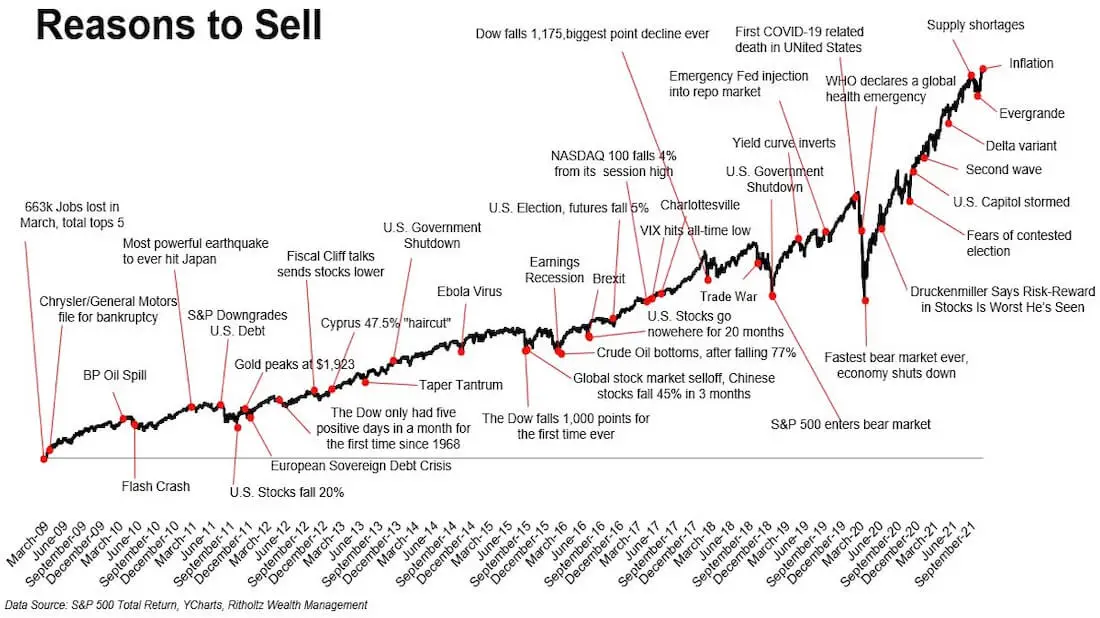A two-year bull run in stocks that began at the depths of the coronavirus panic came close to crashing into a bear market late in May.
Although the market has recovered slightly, as of this writing the C-Fund is still Dow 15%, the I-Fund is -12% and the S-Fund is down over 20%. Even the F Fund is struggling being down almost 9%
What’s driving this? Most experts agree that it is the stubbornly high inflation and the aggressive response for the Federal reserve to get it under control. (And throw a little Russia/Ukraine war into the mix as well)
Does this mean we should sell and go to the G Fund?
Perhaps, or perhaps not. Just like the chart above illustrates, there is ALWAYS a reason to sell!
Which one of these past ‘reasons’ was your favorite? Brexit? Government Shutdown? Trade Wars? Contested Presidential Elections? Ebola?
Remember when a barrel of oil went negative? The economy was moving so slowly that they couldn’t give a barrel of oil away. That was a major problem.
Now gas is almost $5.00 a gallon. This is also a major problem.
Do you remember the Flash Crash? The stock market fell 9% in a matter of minutes. In today’s term, that’s about a 3,000-point drop.
Taking a closer look at the chart reveals something interesting. Despite all of the negative news, the line on the chart seems to go up and to the right.
Presently, the S&P 500 is having its WORST START TO THE YEAR SINCE 1939. The bond market is also off to a record setting start. Heck, even my hometown loveable losers, the Detroit Lions, have done better than either stocks or bonds.
Today’s bear market may have you contemplating selling and going to cash. Undoubtedly, markets like this take a toll on investor psyche.
You might be saying, “Let’s just NOT LOSE money!” I’ll wait for the market to settle down and get back in later. Heck-the G Fund is actually making money.”
Before we do that, let’s put things into perspective.
Since January 1st, 2020, the S&P 500 (C-Fund) has returned +25%. This has happened despite…
- A global pandemic
- The fastest 30% drop in stocks EVER (22 days)
- 8%+ inflation
- An overseas war
- Multiple interest rate hikes
Investing success is built on the principle of buying low and selling high, but executing on this principle is very hard to do in reality. We joke the stock market is the only place that when a sale is on, people run to the exits, rather than the entrance.
Why? One culprit could be that we are having a hard time imagining a future that doesn’t resemble the recent past. It’s easier to believe things will get worse, not better.
Tell someone that everything will be great and they’re likely to either shrug you off or offer a skeptical eye. Tell someone they’re in danger and you have their undivided attention.
–Morgan Housel
Gas won’t be at $5.00 a gallon forever. Inflation will eventually subside. And just like the stock market can’t return 16% per year (like it did from 2019-2022) every year, it also won’t lose 20% per year (like it has now).
If you doubt me, just take a look at Business Week’s magazine cover from August 1979.
With all of the negative news flying around, I hope this longer-term perspective provides a little more clarity to any impact on your Thrift Savings Plan.
Securities and advisory services offered through LPL Financial, a registered investment advisor. Member FINRA/SIPC.
The opinions and forecasts expressed are those of the author, and may not actually come to pass. This information is subject to change at any time, based on market and other conditions and should not be construed as a recommendation of any specific security or investment plan. Past performance does not guarantee future results.”
The Standard & Poor’s 500 Index is a capitalization weighted index of 500 stocks designed to measure performance of the broad domestic economy through changes in the aggregate market value of 500 stocks representing all major industries.




